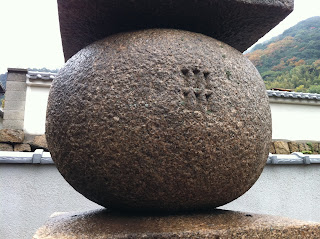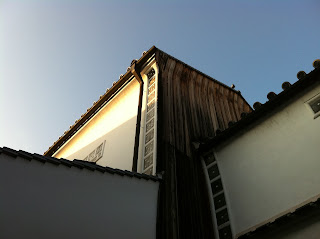 |
| Old pier called Hato built in the Edo and Meiji periods |
Tomo is located in the center of the Seto Inland Sea region and lies 14 km south of JR Fukuyama Station. It protrudes into the Inland Sea at the southern end of the Numakuma Peninsula. The two different tides from the west and the east, meet in the waters off Tomo, which once forced the travelers to stop at Tomo for fair tides and winds to continue their voyages. Fortunately, Tomo’s terrain was ideal for a port. The hills close in to the small flatland and no river runs into the bay, which contributed to make an ideal port of required depth. And of course, Tomo’s inlets were quite suitable for a good moorage.
Tomo is a rare place still retaining the five essential elements for the ports in the Edo period [1603-1868]:
Gangi stairs running into the sea;
Torodo stone lantern once provided a beacon light;
Hato piers made of stacked stones
The ruins of Funabansho maritime office
Tadeba dockyard where the outer ship bottoms were cleaned
Since ancient times when the Anthology of Myriad Leaves was compiled in the 8th century, this once thriving port town has been called Tomo and the same character 鞆, invented in Japan, has been used. That will already convince you what a long and proud history the small port town should have. The town was referred to in the poems of the above-mentioned anthology eight times.
In the 12th century, the court ladies of the once glorious TAIRA clan are said to have been abandoned at Tomo when their troops were escaping from the emerging MINAMOTO forces. The ladies had no choice but to engage in the oldest business in the world.
In the turbulent 14th century, Tomo witnessed battles caused by power struggle in Kyoto in many ways. Kogarasu Shrine where battles were fought still stands although the configuration of the area seems to differ largely from the days of the fighting.
Tomo triggered the Ashikaga clan’s resurgence because ASHIKAGA Takauji received the letter of imperial approval while in Tomo after being ousted from Kyoto and in 1338 he was appointed shogun, starting the Ashikaga Shogunate. Ironically the 15th and last Ashikaga Shogun took refuge in Tomo to revive his authority from ODA Nobunaga in vain.
In the Edo period, when peace was finally established at the beginning of the 17th century, the diplomatic relationship between Korea and Japan was restored and the Korean friendship mission visited Japan 12 times (though they had to stop at Tsushima one time and didn’t come to Tomo as well as Capital Edo). They spent some days at Tomo on their way to Edo and their way back to Korea. That was a pleasure both for the Korean delegates and Tomo locals. Literati came over to meet with the intelligent guests from overseas.
More recently, famed animated film director MIYAZAKI Hayao stayed in Tomo for a while, conceiving of his film “Ponyo,” a story about a little mermaid-like goldfish and a human boy. Now Ponyo’s pictures are commonly seen along the streets of Tomo.
Dr. Donald Keene, a highly respected scholar of Japanese literature, recently retired from Columbia University in 2011 and moved to Japan permanently. Many years ago a school in Fukuyama invited the professor to give a lecture and kindly arranged an overnight stay at the island of Sensui-jima, five minutes’ boat ride from the Tomo terminal, after his lecture. He said he wandered in Tomo alone since he didn’t have a guide. Later he wrote a lyrical article about Tomo in the Yomiuri Newspaper. Some stores in Tomo post the article where it can be seen easily. One store owner said she reads the article occasionally and I saw it framed and hung on the wall. The article advised tourists to be considerate and keep this precious gem intact. I felt like crying.
Any place would inspire you if you listen to the distant voice from numi carefully. This time I had a chance to listen to the message and the affair with Tomo seems to last for quite some time.
 |
Taicho-ro guest house on the premises of Fukuzen-ji temple
Taicho-ro means "the pavilion located where the two tides meet" |
 |
One example of the Tomo Architecture
Houses with this type of plastered walls and windows
were built at the beginning of the 20th century.
Note one of the partitions at the end of the wall on the 2nd floor. |














